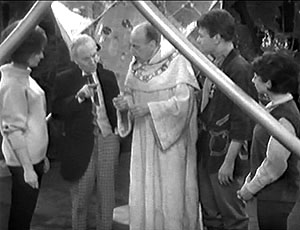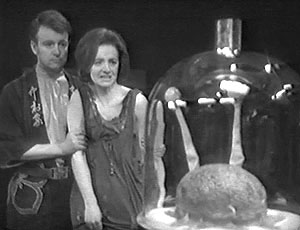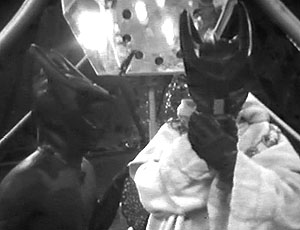 The Doctor and his companions must undertake a series of adventures to recover “the keys of Marinus,” which will bring back to life an ancient computer bent on mentally enslaving an entire planet.
The Doctor and his companions must undertake a series of adventures to recover “the keys of Marinus,” which will bring back to life an ancient computer bent on mentally enslaving an entire planet.
Having just finished a historical excursion, it’s now time for the Doctor and the TARDIS crew to take a futuristic romp.
This six-part serial originally aired form April 11 to May 16, 1964.
Technically, we don’t know whether this story occurs in the past or the future, but it takes place on an alien world with technology more advanced than ours, and that makes it futuristic.
Our heroes emerge from the TARDIS onto a beach. We know we’re on an alien world because of the unusually jagged and un-weathered rocks and mountains in the background. They don’t look like anything you’d find on Earth.
Having just come from the court of Kublai Kahn, Ian is still wearing a Chinese-themed costume, which he keeps on throughout this whole serial (though he occasionally wears other things over is, such as furs to protect him from the cold).
Moving along the beach, Susan wants to go swimming in the water, but when she accidentally drops one of her shoes into it, it turns out not to be water at all but acid, and the shoe dissolves! Yes! The TARDIS crew is standing on the shore of a sea of deadly acid–which is great sci-fi window dressing (in addition to the jagged rocks and mountains).
As the regular characters interact, we see several things approaching the shore that look like plastic water bottles with fins. It eventually turns out that these are meant to be much larger than plastic water bottles. They also aren’t plastic. Instead, they are one-man glass submarines.
While retrieving new shoes from the TARDIS, Susan is stalked by a man in a rubber diving suit with a weird headdress. He apparently came ashore in one of the on-man submarines.
Not all of his companions made it, however, as the Doctor, Ian, and Barbara find a sub that has an empty rubber diving suit within it. This suit has a hole, and they deduce that the acid dissolved the occupant. This represents a double failure: Not only did the protective glass sub fail, so did the protective rubber suit.
In the distance, beyond the jagged mountains, there is an impressive, futuristic building, and our characters head over there. They are individually taken prisoner by rotating panels in or on the building.
The guys in the wetsuits also invade the structure, but things go even worse for them. When one of them attacks Ian, he is flipped through a hole in the floor to fall to his death in the acid sea, below.
Eventually, our heroes make contact with a man with the completely arbitrary name Arbitan. He is dressed in white, monk-like robes, and he explains that at first he did not know if the TARDIS crew were hostiles, like the wetsuit dudes, but now he sees that they are not.
He shows them a huge, clear-plastic MacGuffin machine, which he describes as “the Conscience of Marinus.” Marinus, it turns out, is the planet on which they have landed.
He reveals that the Conscience of Marinus is a more-than 2,000-year old computer which originally served as judge and jury, and it was never wrong or unfair.
Already, many people in the audience are freaking out. Computers that decide right and wrong for everyone are notoriously dangerous in sci-fi and the whole concept is unbelievably creepy.
Despite this, our heroes don’t bat an eyelash, and, after quickly reviewing several radio programs’ ratings, Arbitron–uh, Aribtan–proceeds to say that the Conscience was eventually improved so that its reach was expanded (GAH!), its will was irresistible (GAH!), and no man henceforth had to decide for himself what was right or wrong–the Conscience did that for him (GAHHH!!!).
So, the Doctor observes, “it was possible to eliminate evil from the minds of men for all time.” Aribtan confirms this. (GAAAHHHH!!!!!!!!)
He then explains that Marinus had 700 years of really groovy, machine-induced subjugation of society before a man named Yartek discovered a way to resist the Conscience, and he and his followers–the wetsuit-clad guys, who we learn are called the Voords–started a rebellion. (GO, YARTEK! GO, VOORDS!)
“Unfortunately” the now-pacified Marinans were now too used to being machine-dominated cow-humans to resist the Voords, and their paradise disintegrated.
Arbitan explains that his group always hoped to find a way to modify the Conscience and again make its influence irresistible, and so they removed the “five key microcircuits” (there’s the word “key” from the title) from it and hid them around Marinus in anticipation that they could one day be plugged back in and the whole of their planet could again be denied of free will and subjected to the machine of their making.
He’s got one of the keys, himself, but the other four have been cleverly hidden.
Although Aribitan has sent all of his followers in search of the keys, none have come back–not even his daughter.
When our heroes return to the TARDIS, they discover that Aribtan has surrounded it with a force field, and he will not let them leave unless they scour Marinus for the four missing keys.
This makes The Keys of Marinus precisely the kind of MacGuffin-hunt plot that I despise. It is mindless, paint-by-numbers plotting, in which the characters have to collect a series of items–frequently placed in unpredictable locations–that somehow enable the use of the Master MacGuffin (the Conscience of Marinus) at the finale of the series.
This is one of the worst, most-overused, most-predictable story structures out there.
What makes this worse is the fact that the Doctor and company don’t even blink when Arbitan won’t let them back into the TARDIS. Instead, they willingly accept his quest to retrieve the Keys of Marinus, without even seeming to care that the restoration of these devices will result in an entire planet losing its free will in the face of computerized domination.
I’m sorry, but Doctor Who should be fighting on the other side of this equation! He should be protesting the domination of men by computers and helping them throw off the shackles of their mechanical overlords.
To help the Doctor and companions find the missing keys, Arbitan gives them teleporter wristwatches (I think Apple is working on those) that have been pre-set to the general locations of where the keys can be found.
After they leave, a Voord appears and kills Arbitan.
 In this episode, the travelers go to the city with the improbable name of Morphoton. At first, it seems beautiful, and the inhabitants seek to satisfy the every desire of the TARDIS crew.
In this episode, the travelers go to the city with the improbable name of Morphoton. At first, it seems beautiful, and the inhabitants seek to satisfy the every desire of the TARDIS crew.
Something, however, is a foot, and while the gang is sleeping, a hypnotized woman places hypnotic devices on their foreheads.
Fortunately, Barbara’s hypno device falls off, leaving her unaffected. In the morning, we see things from her POV and realize that Morphoton is not the beautiful city it appears. It is run down and ratty, but the others continue to see it as beautiful.
Eventually, Barbara learns that the city is under the mental domination of a group of brains that have slug-like eyestalks and that live in glass cases. They are the Morpho.
Fortunately, Barbara is able to defeat the Morpho by smashing their glass cases, and everyone in the city is freed from their mental domination.
Among those so freed are a young man (Altos) and a young woman (Sabetha), who are two of Arbitan’s agents. The young woman, in fact, is his daughter, and she was wearing one of the missing keys around her neck the whole time. These two quickly join the quest to help find the rest of the keys.
It’s really interesting that the writers chose to have the second episode be about a mind-controlled city when they are trying to restore mind control to an entire planet. It’s even more interesting that the mind-control doesn’t lead to such great results in the city. Yet they don’t seem to draw any lessons from this about restoring mind control to the whole planet.
At the end of the episode, the Doctor teleports two jumps ahead of the others so that William Hartnell can have a vacation and be missing from the show in the next episode.
In this episode, the Doctor-less cast finds itself in a jungle that makes strange screaming noises. They also find and old building that is inhabited by an old scientist.
And they find a fake key.
The scientist is dying, but he knows where the missing real key is, and he gives Ian and Barbara the mysterious phrase D-E-3-O-2 and points them to his lab. Then he dies.
The jungle outside turns out to have been the subject of his experiments, and they are responsible for its screaming noises. They are also responsible for the fact that the plants are now animate and capable of attacking people.
The jungle starts to attack the lab, but Ian and Barbara are able to figure out that D-E-3-O-2 is not the combination to the scientist’s safe (as they first thought) but a chemical formula: DE3O2. They then find a flask with this label and retrieve the key that is buried in it. (Fun science fact: While O is the symbol for Oxygen, there are no elements at present with the symbols D or E.)
Ian and Barbara find themselves in a frozen wasteland, where a large trapper takes them in and helps them recover from near-frostbite.
Soon Ian goes in quest of Susan, Altos, and Sabetha, and in his absence the most amazing thing happens. It’s something I never dreamed I would see on Doctor Who–especially in an episode from 1964.
After Barbara is alone with the trapper, he tries to rape her! They don’t say that’s what’s happening, presumably so that the children in the audience don’t realize it, but that clearly is what is happening. After clumsily trying to woo her, the trapper starts chasing her around the cabin shouting, “I won’t wait any longer!”
Of course, he does not succeed, but it is a dramatic and disturbing scene. I’m gobsmacked that they put it on a teatime family program in the early ’60s.
Ian and Barbara are reunited with the others, and they find themselves in an ice cave looking for the next key. It turns out that it’s embedded in a block of ice that is being guarded by several motionless swordsmen.
The block of ice is in contact with a water pipe that the characters find is connected to a volcanic hot spring. They turn on the water and the block starts to melt, allowing the to take the key.
This causes the swordsmen to come to life, and they flee back to the trapper’s cabin, where he is swiftly impaled by one of them.
They then use their teleport watches to escape, and Ian finds himself looking at a glass case holding the next key. On the floor next to the case is a dead man.
Ian is then knocked unconscious.
It turns out that the characters are in the advanced city of Millennius, which has a guilty-until-proven-innocent justice system.
This is not so good for our heroes, because Ian is accused of killing the man found by the glass case and of taking the key (which is now missing).
Unless Ian’s innocence can be proved in court, he will be executed.
The Doctor, who had jumped ahead to this location, volunteers to serve as Ian’s defense attorney, and we have a rather awkward alien trial sequence, and the Doctor fails. Ian is sentenced to death.
 Fortunately, while the Doctor is failing, Ian, Susan, and Barbara uncover the truth, which is that the man was killed by agents of Yartek–the guy who figured out how to resist the Conscience of Marinus and who is apparently still alive all this time later.
Fortunately, while the Doctor is failing, Ian, Susan, and Barbara uncover the truth, which is that the man was killed by agents of Yartek–the guy who figured out how to resist the Conscience of Marinus and who is apparently still alive all this time later.
Ian gives the keys to Yartek, who is very implausibly disguised as Arbitan, wearing the large plastic diver’s headgear (or whatever it is) underneath Arbitan’s monk’s cowl and sounding nothing like him.
It turns out that Ian isn’t such a fool, though, because he didn’t give Yarnek the correct set of keys. Instead, he deliberately gave him a set including the false key they found in episode 2.
This makes the Conscience explode when the keys are inserted, killing Yarnek and the Voord and leaving the inhabitants of Marinus free from machine domination.
The Doctor says that’s a good thing, that man was not meant to live by machine conscience alone, and the TARDIS crew leaves.
Despite the fact that this is a MacGuffin-hunt story of precisely the kind I despise, the individual parts of it work surprisingly well. The overarching story is totally paint-by-numbers, but at least the fact that they take us to so many different locations, with different story types, keep things moving and not feeling the same.
In episode 2 we had a apparently gorgeous city that turned out to be rubbishy and ruled by hypnotic brain slugs. In episode 3 we had a mystery in a jungle that turned out to be alive. In episode 4 we had a survival story in the arctic. And in the last two we had a courtroom drama in a technologically advanced city.
That’s a good mix!
It’s so good, in fact, that they would later recycle it as the overall plot of the 1978-1979 season, in which Tom Baker had to find all the hidden components of “The Key to Time” and reassemble an ancient device capable of stopping the entire universe. Arbitan and Yartek are paralleled in that story by the White Guardian and the Black Guardian, and we even have the bit about the latter impersonating the former in the final episode.
Apparently, the Doctor remembered this previous adventure, because he sees through the Black Guardian’s disguise and re-scatters the components to the Key to Time.
Despite its good points, this serial has a central flaw from the outset that is really hard to overlook–the fact that the Doctor and crew are attempting to help reassemble a device whose explicit purpose is to place an entire planet under mental domination.
That’s just wrong.
The fact that the Doctor, in the end, expresses a mild preference for men not living under the mental domination of machines does not redeem the fact that he has been willing to go along with the plan for all the previous episodes and never said anything critical of it–much less did he work to subvert the plan so that the inhabitants of Marinus could live free.
The story thus raises huge ethical questions that it fails to deal with properly, however interesting the individual episodes of the MacGuffin-hunt may be.
RATING: * * 1/2
WATCH THIS STORY YOURSELF:
{ 0 comments… add one }